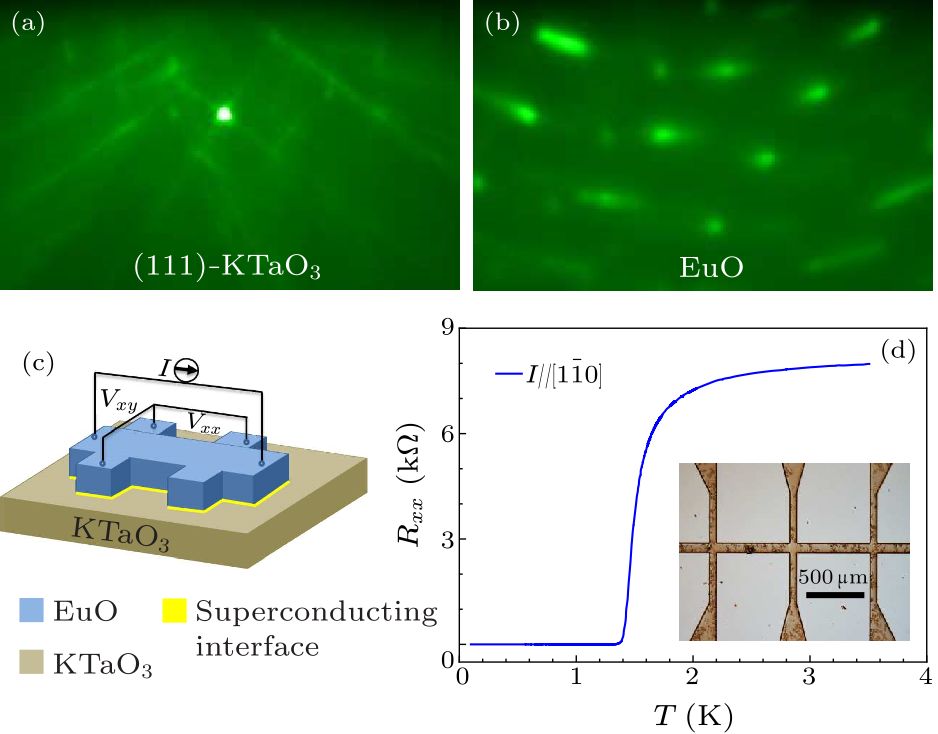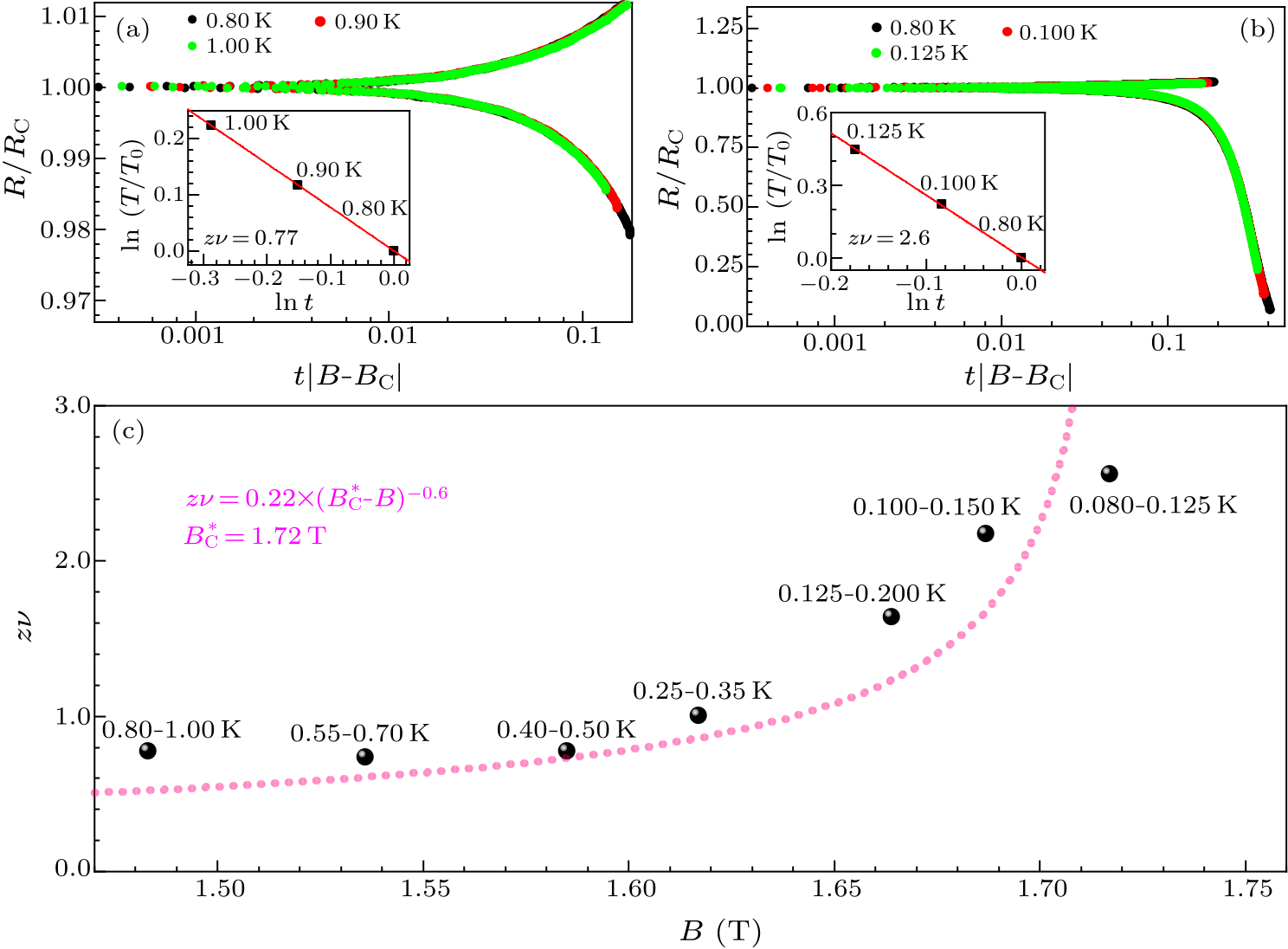
Fig. 1. Growth and electrical measurement of the superconducting EuO/(111)-KTaO$_{\boldsymbol{3}}$ interface. (a) and (b) RHEED patterns of a typical (111)-oriented KTaO$_{3}$ substrate and the polycrystalline EuO thin film ($\sim $10 nm) viewed from the KTaO$_{3}$ crystal's [1$\bar{1}$0] direction. (c) Schematic of the EuO/KTaO$_{3}$ Hall bar device and measurement geometry. (d) The longitudinal resistance ($R_{xx}$) as a function of temperature on the EuO/KTaO$_{3}$ Hall bar device. Inset: the optical image of the Hall bar device.

Fig. 2. The BKT transition of the superconducting EuO/(111)-KTaO$_{\boldsymbol{3}}$ interface. (a) The temperature dependence of the longitudinal resistance of the EuO/KTaO$_{3}$ Hall bar device under various magnetic fields. The magnetic field is applied perpendicular to the interface. (b) The magnetic field dependence of the longitudinal and Hall resistances of the EuO/KTaO$_{3}$ Hall bar device at $T = 91$ mK. The purple dashed line represents the best linear fit for the Hall resistance at large magnetic fields. (c) The log-log curves of current-voltage dependence between $T = 1.3$ and 1.6 K. The red dashed line represents the relationship of $V \sim I^{3}$. (d) The BKT transition temperature ($T_{\rm BKT}$) determined from the power coefficient ($\alpha$) vs $T$. Inset: The current-voltage curves at $T = 1.3,\, 1.34,\, 1.4$, and 1.6 K, respectively.

Fig. 3. Magnetoresistance isotherms of the superconducting EuO/KTaO$_{\boldsymbol{3}}$ interface. The magnetic field dependence of the longitudinal resistance of the EuO/KTaO$_{3}$ Hall bar device at various temperatures. Inset: the temperature dependence of the crossing magnetic field ($B_{\rm C}$) that could be extracted from $R_{xx}$ vs $B$ curves at every two adjacent temperatures.

Fig. 4. Experimental evidence of quantum Griffiths singularity at the EuO/KTaO$_{\boldsymbol{3}}$ interface. (a) and (b) The scaling analysis of the interface superconductivity for two typical temperature regimes (0.80–1.00 K and 0.080–0.125 K). (c) The magnetic field dependence of dynamical critical exponent ($z\nu$) in various temperature regimes. The purple dashed line represents the best fit based on the equation $z\nu =0.22\times {(B_{\rm C}^{\ast }-B)}^{-0.6}$.
| [1] | Saito Y, Nojima T and Iwasa Y 2017 Nat. Rev. Mater. 2 16094 | Highly crystalline 2D superconductors
| [2] | Caviglia A D, Gariglio S, Reyren N, Jaccard D, Schneider T, Gabay M, Thiel S, Hammerl G, Mannhart J and Triscone J M 2008 Nature 456 624 | Electric field control of the LaAlO3/SrTiO3 interface ground state
| [3] | Li L, Richter C, Mannhart J and Ashoori R C 2011 Nat. Phys. 7 762 | Coexistence of magnetic order and two-dimensional superconductivity at LaAlO3/SrTiO3 interfaces
| [4] | Bert J A, Kalisky B, Bell C, Kim M, Hikita Y, Hwang H Y and Moler K A 2011 Nat. Phys. 7 767 | Direct imaging of the coexistence of ferromagnetism and superconductivity at the LaAlO3/SrTiO3 interface
| [5] | Dikin D A, Mehta M, Bark C W, Folkman C M, Eom C B and Chandrasekhar V 2011 Phys. Rev. Lett. 107 056802 | Coexistence of Superconductivity and Ferromagnetism in Two Dimensions
| [6] | Reyren N, Thiel S, Caviglia A D, Kourkoutis L F, Hammerl G, Richter C, Schneider C W, Kopp T, Rüetschi A S, Jaccard D, Gabay M, Muller D A, Triscone J M and Mannhart J 2007 Science 317 1196 | Superconducting Interfaces Between Insulating Oxides
| [7] | Liu C J, Yan X, Jin D F, Ma Y, Hsiao H W, Lin Y L, Bretz-Sullivan T M, Zhou X J, Pearson J, Fisher B, Jiang J S, Han W, Zuo J M, Wen J G, Fong D D, Sun J R, Zhou H and Bhattacharya A 2020 arXiv:2004.07416 [cond-mat.supr-con] | Discovery of two-dimensional anisotropic superconductivity at KTaO$_3$ (111) interfaces
| [8] | Fisher D S 1992 Phys. Rev. Lett. 69 534 | Random transverse field Ising spin chains
| [9] | Fisher D S 1995 Phys. Rev. B 51 6411 | Critical behavior of random transverse-field Ising spin chains
| [10] | Xing Y, Zhang H M, Fu H L, Liu H, Sun Y, Peng J P, Wang F, Lin X, Ma X C, Xue Q K, Wang J and Xie X C 2015 Science 350 542 | Quantum Griffiths singularity of superconductor-metal transition in Ga thin films
| [11] | Shen S, Xing Y, Wang P, Liu H, Fu H, Zhang Y, He L, Xie X C, Lin X, Nie J and Wang J 2016 Phys. Rev. B 94 144517 | Observation of quantum Griffiths singularity and ferromagnetism at the superconducting interface
| [12] | Xing Y, Zhao K, Shan P, Zheng F, Zhang Y, Fu H, Liu Y, Tian M, Xi C, Liu H, Feng J, Lin X, Ji S, Chen X, Xue Q K and Wang J 2017 Nano Lett. 17 6802 | Ising Superconductivity and Quantum Phase Transition in Macro-Size Monolayer NbSe 2
| [13] | Saito Y, Nojima T and Iwasa Y 2018 Nat. Commun. 9 778 | Quantum phase transitions in highly crystalline two-dimensional superconductors
| [14] | Zhang E, Zhi J, Zou Y C, Ye Z, Ai L, Shi J, Huang C, Liu S, Lin Z, Zheng X, Kang N, Xu H, Wang W, He L, Zou J, Liu J, Mao Z and Xiu F 2018 Nat. Commun. 9 4656 | Signature of quantum Griffiths singularity state in a layered quasi-one-dimensional superconductor
| [15] | Liu Y, Wang Z, Shan P, Tang Y, Liu C, Chen C, Xing Y, Wang Q, Liu H, Lin X, Xie X C and Wang J 2019 Nat. Commun. 10 3633 | Anomalous quantum Griffiths singularity in ultrathin crystalline lead films
| [16] | Zhang C, Fan Y, Chen Q, Wang T, Liu X, Li Q, Yin Y and Li X 2019 NPG Asia Mater. 11 76 | Quantum Griffiths singularities in TiO superconducting thin films with insulating normal states
| [17] | Yun Y, Ma Y, Su T, Xing W, Chen Y, Yao Y, Cai R, Yuan W and Han W 2018 Phys. Rev. Mater. 2 034201 | Role of La doping for topological Hall effect in epitaxial EuO films
| [18] | Wang P, Huang K, Sun J, Hu J, Fu H and Lin X 2019 Rev. Sci. Instrum. 90 023905 | Piezo-driven sample rotation system with ultra-low electron temperature
| [19] | Berezinskii V L 1971 Sov. Phys.-JETP 32 493 |
| [20] | Berezinskii V L 1972 Sov. Phys.-JETP 34 610 |
| [21] | Jm K and Thouless D J 1972 J. Phys. C 5 L124 | Long range order and metastability in two dimensional solids and superfluids. (Application of dislocation theory)
| [22] | Epstein K, Goldman A M and Kadin A M 1981 Phys. Rev. Lett. 47 534 | Vortex-Antivortex Pair Dissociation in Two-Dimensional Superconductors
| [23] | Sondhi S L, Girvin S M, Carini J P and Shahar D 1997 Rev. Mod. Phys. 69 315 | Continuous quantum phase transitions
| [24] | Goldman A M 2010 Int. J. Mod. Phys. B 24 4081 | SUPERCONDUCTOR-INSULATOR TRANSITIONS
| [25] | Fisher M P A 1990 Phys. Rev. Lett. 65 923 | Quantum phase transitions in disordered two-dimensional superconductors
| [26] | Vojta T, Farquhar A and Mast J 2009 Phys. Rev. E 79 011111 | Infinite-randomness critical point in the two-dimensional disordered contact process
| [27] | Kovács I A and Iglói F 2010 Phys. Rev. B 82 054437 | Renormalization group study of the two-dimensional random transverse-field Ising model
| [28] | Markovic N 2015 Science 350 509 | Randomness rules
| [29] | Vojta T and Hoyos J A 2014 Phys. Rev. Lett. 112 075702 | Criticality and Quenched Disorder: Harris Criterion Versus Rare Regions
| [30] | Vojta T 2006 J. Phys. A 39 R143 | Rare region effects at classical, quantum and nonequilibrium phase transitions
| [31] | Spivak B, Oreto P and Kivelson S A 2008 Phys. Rev. B 77 214523 | Theory of quantum metal to superconductor transitions in highly conducting systems
| [32] | Kapitulnik A, Kivelson S A and Spivak B 2019 Rev. Mod. Phys. 91 011002 | Colloquium : Anomalous metals: Failed superconductors